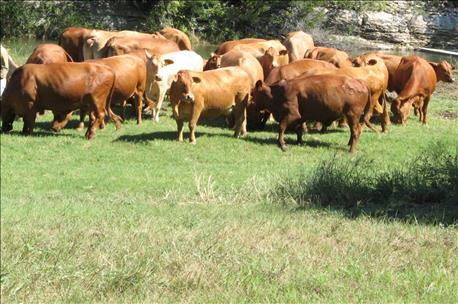
Sometimes I think my specialty has become gullied-out farms that more closely resemble a vacant parking lot than a pasture. That is about the only thing available to buy or rent, and these places are no longer easy to find.
Remember that without our intervention the cattle will die or leave before the grass does. Feeding hay on drought-stricken barren pastures and opening gates is one of the biggest errors that North American cattlemen have instituted in the last fifty years. This is another example that throwing money at a problem can result in a bigger problem.

Managing stocking levels, and moving cattle daily can speed up development of healthy soil.
Destock or tighten the cattle up and unroll hay, and wish you had destocked later. You will not grow quality plants with cattle standing on top of them. Even in drought there is some rain and if cattle are present they will pick it.
We are in the solar and water business. Establish solar panels with leaves and catch and hold the rain. I need to read these statements to myself regularly.
Soil health loss likely had a lot to do with the westward movement of the pioneer farmers from the east as they left worn out land behind and started anew for two hundred plus years until there was basically no new place to go.
Back in the 1930’s the Federal government got involved and tried several programs that resulted in very little success. We did learn not to remove the animals for really long periods (over 24 to 36 months). We also learned not to terrace water into wood lots and create new massive gullies.
Most of what we have tried or been taught to do for growing plants results in the further demise of soil health. Soil health and wealth is mostly the result of goodly to high levels of organic matter and mineralization.
The mining and destruction of organic matter is mostly complete. Chemical acid fertilizer and tillage polished most of what was left 70 years ago. Set stocked cattle on a fescue based pasture in humid country can hold soil but after 65 years of this management we have not built organic matter or topsoil. Reducing the stocking rate does not change the condition but only slows it down. Haying makes it worse.
If we cannot graze through a drought the best time to destock is early, very early. We look to see what most everyone is doing and work out an almost opposite plan. Old cows, calves, and yearlings usually need to be sold first.
Principles to build soil fast are the same as the principles to build soil slow with a little tweaking and very little money expenditure. They include:
• Allowing for the complete growth of diverse warm season (C4) grass, legumes, and forbs. We call this complete recovery. It is critical for success.
• Stopping tillage with the possible exception of a little subsoiling initially to Band-Aid the water runoff.
• Breaking the cattle completely to one wire electric fencing. In very dry areas 2 wires are necessary but one wire can often be used for daily moves. It just doesn’t take much electricity for sure enough broke cattle.
• Grazing the completely recovered growth with high cattle densities and once or more daily moves. Multiple daily moves may not have a 100% multiplying effect but they are magical. Shoot for manure pies every 3 to 6 feet, a grazing hit on every plant species, 80 to 90% opening of the canopy, and several inches of litter on the ground. Supplement the cattle with bean meal and go up to 1 lb. of corn per 250 lbs. body weight if needed. Do not forfeit body condition of the cattle. Feed lime and other minerals, trace minerals and salt. The further you are from limestone and the more humid your country, the more you need to feed salt, lime and minerals.
• Keeping the ground covered year round.
• Managing toward tall warm season plants. A ratio of 70:30 (C4 to C3) might be near perfect.
• Removing the chemicals from the pasture and from all but use on individual cattle.
• Removing the cattle and allow the pasture to completely recover. If there aren’t seeds the pasture is probably not recovered.
• Repeating the process every 6 to 30 months.
Adopt a ‘boom and bust’ mindset and execution of ranching. In two to five years or less you will start seeing good big things happen!
About the Author(s)
You May Also Like






